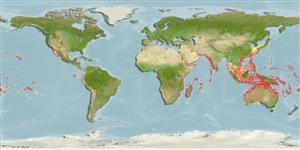Common names from other countries
Classification / Names / Names
Namen | Synonyme | Catalog of Fishes (gen., sp.) | ITIS | CoL | WoRMS
Environment: milieu / climate zone / depth range / distribution range
Ökologie
Riff-verbunden; brackwasser; tiefenbereich 0 - 95 m (Ref. 96667). Tropical
Indo-Pacific: Red Sea to Cocos Islands.
Length at first maturity / Size / Gewicht / Alter
Maturity: Lm ? range ? - ? cm Max length : 2.0 cm CL Männchen/unbestimmt; (Ref. 107481); 2.325 cm CL (female)
It is found on pneumatophores and roots of Avicennia marina (Ref. 107904). Active during low tide, but many are observed at high tide moving to mangrove roots above water level. Also lives among roots of Rhizophora mucronata. Feeds on mainly on macroalgae, a bit of mangrove leaves and mud; animal items were rare but may be an opportunistic feeder to a certain degree (Ref. 108401).
Life cycle and mating behavior
Geschlechtsreife | Fortpflanzung | Ablaichen | Eier | Fecundity | Larven
Members of the order Decapoda are mostly gonochoric. Mating behavior: Precopulatory courtship ritual is common (through olfactory and tactile cues); usually indirect sperm transfer.
MarineSpecies.org. 2050. (Ref. 3477)
IUCN Rote Liste Status (Ref. 130435)
CITES Status (Ref. 108899)
Not Evaluated
Not Evaluated
Nutzung durch Menschen
| FishSource |
Tools
Mehr Information
Alter/Größe
Wachstum
Länge-Gewicht
Länge-Länge
Morphologie
Larven
Dichte
Internet Quellen
Estimates based on models
Preferred temperature
(Ref.
115969): 24.3 - 29, mean 27.7 (based on 1472 cells).
Preiskategorie
Unknown.
